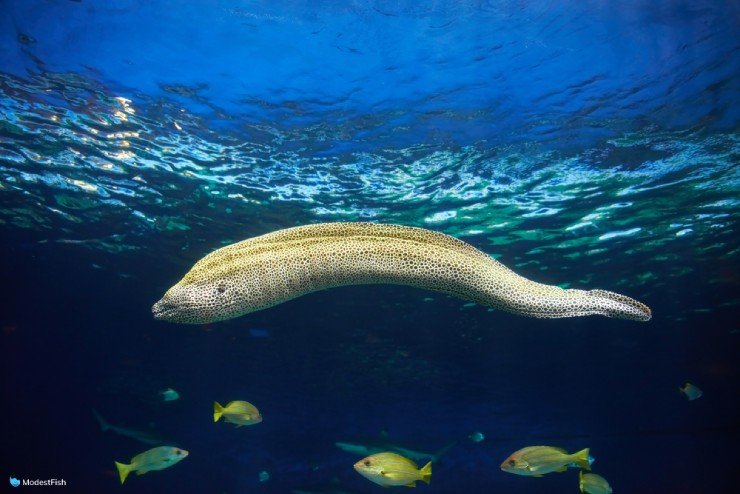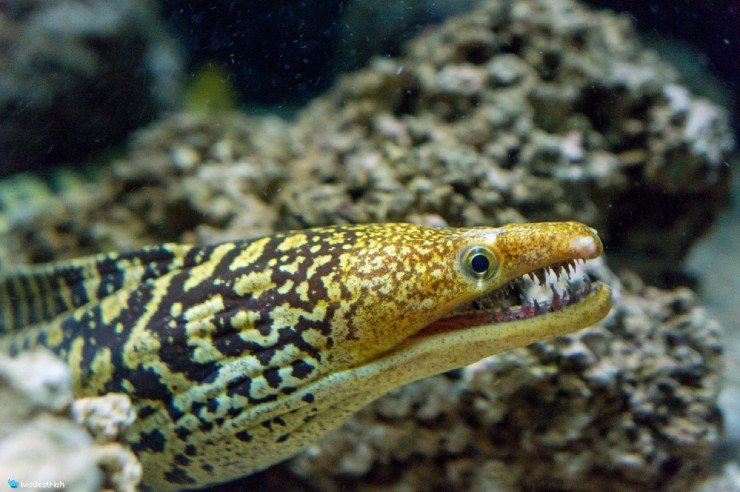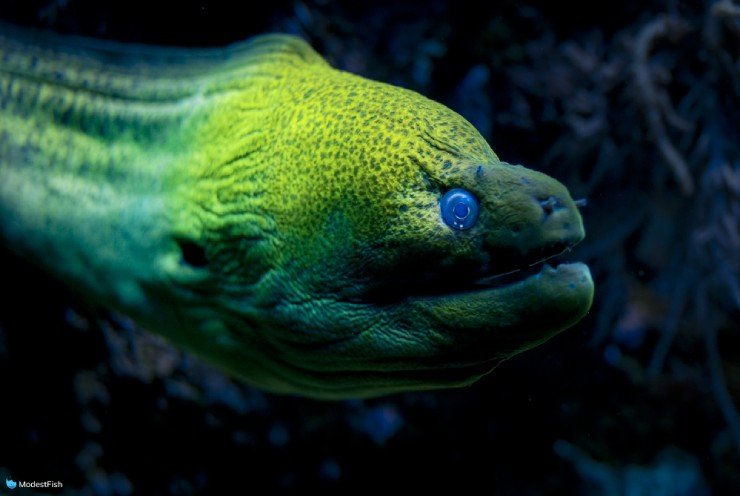“Moray eel” is a wide variety of species of eels that can be found all over the world. They’re certainly some of the most exciting life forms in Oceania. Their peculiar colors and shape can make for quite an experience for divers or snorkelers.
There are around 200 species of moray eel. They’re usually found around coral reefs; scuba divers often want to see moray eels during their lives as they witness the beauty of the aqua life.
Despite their numerous species, the most likely ones to be kept in an aquarium are the Snowflake moray eels and Zebra moray eels. Although they are pretty entertaining to observe, moray eels spend most of their time hidden – chilling – beneath rocks and reefs.
The evolutionary masterpiece that is the moray eel can be fun to learn about, and they require certain conditions to survive as in their natural habitat.
Let’s dive into their anatomy, understand their physique, and explore the conditions they need to be appropriately kept in aquariums.
Anatomy of Moray Eel

Scientifically speaking, moray eels are called the family Muraenidae, which is divided into two subcategories. They have different appearances and colors. However, they all share snake-like, weird looks.
Body
Moray eels are often compared to snakes in their movement. However, unlike snakes, they’re entirely scaleless. They mainly move around using sleeky, serpentine-like signals.
Moray eels’ bodies are known to have a mucus layer covering them entirely. They have specific cells called goblet cells; they secrete the mucus over their bodies to protect themselves from scraping and chafing while hiding under rocks.
In some species, the mucus layer can be pretty toxic; that’s why divers shouldn’t strive too eagerly to touch them.
They are also known to have poor vision. Being nocturnal species, they’re unable to see well underwater in the dark as they lack the visual ability to do so.
Moray eels have pretty large and prominent nostrils. They mainly rely on chemoreception to locate and catch their prey.
Fins
Moray eels have a dorsal fin that runs the length of their backs. They’re linked to their caudal and anal fins. Yet, they lack pectoral and pelvic fins.
Jaw

One of the most exciting things about moray eels is their jaws. Most of them have large pointy teeth that help them catch slippery fish.
A commonly known moray eel is the fangtooth moray eel. They have a prominent, elongated jaw that holds a terrifying amount of sharp, glassy teeth.
Others, like the snowflake moray eel, commonly referred to as the millennial moray eel, prey primarily on crustaceans and hard-shelled sea creatures. Because of that, evolution helped them develop blunt, strong teeth that can crack open the shells of their game.
Another species, the leopard moray eel, has translucent teeth that have a glassy look.
They mostly have two sets of jaws; one is the regular or oral jaw which can be a bit scary, and the second set of jaws located at their throats. The second set of jaws is known as the Pharyngeal jaws. It gives quite an advantage when it’s time to eat.
When they catch prey, the Pharyngeal jaw shoots forwards at the prey caught with the oral jaws and grabs and pulls down the eel’s throat. They’re the only known species to have two sets of jaws.
One more interesting fact is that California moray eels have other teeth on the roof of their mouths. They further help prevent the prey from moving around in their mouth and allow the Pharyngeal jaws to grab the prey smoothly.
How Big Can Moray Eels Get?
Moray eels have very distinct colors and vary in size. Although the majority of them are often around a meter and a half in length, some of them can exceed that.
One specific species, Thyrsoidea macrurus, which is often found in the Pacific, can grow up to three and a half meters (11 feet).
Ciguatera Poisoning
In some parts of the world, moray eel is a typical meal. It’s even said that Romans used to raise and have eels as a delicacy meal, especially Muraena Helena, found in the Mediterranean.
Some of those species are pretty toxic, though. If ingested, the poisonous fish can lead to illnesses and, in some cases, even death.
It’s known as Ciguatera poisoning, which is an uncommon disease that happens if you ingest some specific, toxic fish.
The toxic substance is called ciguatoxin; when ingested, it can damage different body functions. The neurological, digestive, and muscular systems get affected and allow the disorder to settle.
Some moray eels species are known to be one of the 400 fish species that can cause Ciguatera poisoning.
If you happen to eat of those, we can’t promise you’d have the best time. Its symptoms can be quite a debacle.
The symptoms include, but are not limited to, nausea, diarrhea, numbness in the limbs and tongue, and abdominal cramps. There are possibilities for other symptoms to develop from the toxin.
Although the symptoms often fade within a couple of days, some can persevere. The neurological damage can go along for a while.
Habitat

Moray eels are friendly creatures that often preside in cosmopolitan areas. They remarkably rather stay in warmer waters around coral reefs.
They can withstand depths up to a few hundred meters beneath the surface. It creates a suitable habitat for them as they prefer to chill hidden under rocks and in some crevices.
The vast majority of moray eels are known to inhabit saltwater. However, a small number of them can live well where fresh and saltwater collide.
The ones known to inhabit these areas are species like the Pink-lipped moray eel and the Freshwater one.
Feeding: What Do Moray Eels Eat?
Moray eels have a peculiar way of feeding. They aren’t necessarily the best swimmers as they don’t have a pectoral fin. So, they primarily just hide in caves targeting any prey that comes close.
Moray eels often go for smaller fish and crustaceans. Although their go-to is ambushing their prey, they cultivated other hunting methods by chasing the prey.
Co-operative Hunting
Some moray eels tend to group with other fish in hunting. For example, Giant moray eels can team with groupers to catch prey.
Groupers live and hunt in open water. Their prey tends to escape them in the corals. Diversely, moray eels live in corals, and their prey escapes them in open waters.
They work together, and if the prey is scared of either fish, the other one gets to eat it.
Taxonomy
Scientifically speaking again, moray eels are classified into different kingdoms. It can be categorized as follow:
- Common Name: moray, moray eel, painted eel
- Kingdom: Animalia
- Phylum: Chordata
- Class: Osteichthyes
- Order: Anguilliformes
- Family: Muraenidae
- Genus: SpeciesGymnothorax spp.
Genera
The numerous species of moray eels have various classifications. Delving into their around 16 categories, we can list a number of species as below:
Subfamily Muraeninae
- Diaphenchelys
- Echidna
- Enchelycore
- Enchelynassa
- Gymnomuraena
- Gymnothorax
- Monopenchelys
- Muraena
- Pseudo Echidna
- Rhinomuraena
- Strophidon
Subfamily Uropterygiinae
- Anarchias
- Channomuraena
- Cirrimaxilla
- Scuticaria
- Uropterygius
Moray Eels in the Aquarium Trade
Keeping and raising moray eels can seem a bit of a handful. Yet, you can create the proper setting in the aquarium. Depending on the species, size, and natural habitat, the aquarium can be set up accordingly.
One of the most important things to keep in mind is the tank size; moray eels are carnivores that happen to leave immense amounts of waste. The waste is nitrogenous, so that the tank might end up with a significant amount of ammonia.
Luckily, there are ways you can control the nitrogen and pH levels in your tank. You can learn more about the Nitrogen and Biological cycles to ensure the environment is safe for the eel.
You should also keep in mind the pH levels in your tank. It’s pretty essential to make sure their levels are low to maintain the safety of the aquarium.
It might seem too much to sustain a supply of fresh seafood for the eels. It would be best to train them to get used to consuming frozen foods instead.
For your safety, you’ll want to make sure to avoid their fierce teeth. It would be best if you have a long tool to use for feeding them.
There are specific schedules for feeding moray eels depending on their age. It’s said that some eels can die from overfeeding.
For the older eels, feeding them once a week would be sufficient. However, for the younglings, you should provide them twice a week.
Of course, there are certain foods to give them. They vary in quality, and they can make a difference in the eels’ feeding cycle. You can learn more about them here.
The fascinating creatures that are moray eels can be pretty entertaining to raise. Keeping your tank up to standards can be a handful but is quite needed. The quality of your tank makes all the difference in sustaining a proper environment for the eel.
